Resources
Activity Sheet
Navigate our website with this fun and easy activity sheet that you can enjoy with students, family and friends. Connect to the collections with the option to share your knowledge, memories, experiences through our user contribution feature.
Brochure
Discover what the digitalpasifik website offers, and how you can see and access a variety of Pacific treasures virtually. Connect with us if you would like to share your stories and collections on our website.
Download the brochure to share with your school, library, community and organisation.
Copyright Guides
Copyright Use and Reuse Guide
This guide on copyright helps visitors to Digital Pasifik understand what they can and cannot do with content found through this website. Before downloading, copying or reusing any item found through digitalpasifik.org, you need to understand the copyright terms of the item and whether or not:
you can copy and share the item,
you can modify or change the item,
or if you can use the item commercially.
Please note: Digital Pasifik displays copyright information related to collection items directly from the content partner which may not be accurate or up to date.
Sections:
WHAT IS COPYRIGHT?
MATERIAL PROTECTED BY COPYRIGHT
COPYRIGHT OWNERSHIP
COPYRIGHT DURATION
EXCEPTIONS TO COPYRIGHT
HOW CAN I LEGALLY SHARE A WORK FAQ
What is copyright?
Copyright is a legal right that gives creators control over an original work they have created. Copyright protects creators from people copying, sharing or performing their works without permission. Copyright protection exists to encourage the creation of new creative works.
Typically, creators own the copyright to a work they have created and they are able to grant permission for the use of their work. In some situations fees or royalties can be charged for the use of a work.
What does the copyright symbol mean? ©
A copyright symbol lets us know when a work is in copyright and who the copyright owner is. Sometimes, there is no copyright symbol on a work, but it is important to know that the work could still be in copyright, even if there is no copyright symbol.
How does copyright come about?
Legislation sets out specific rules for copyright and each country has their own copyright law. Typically, copyright law arises automatically whenever a new, original work is created.
MATERIAL PROTECTED BY COPYRIGHT
What types of material are protected?
Copyright applies to:
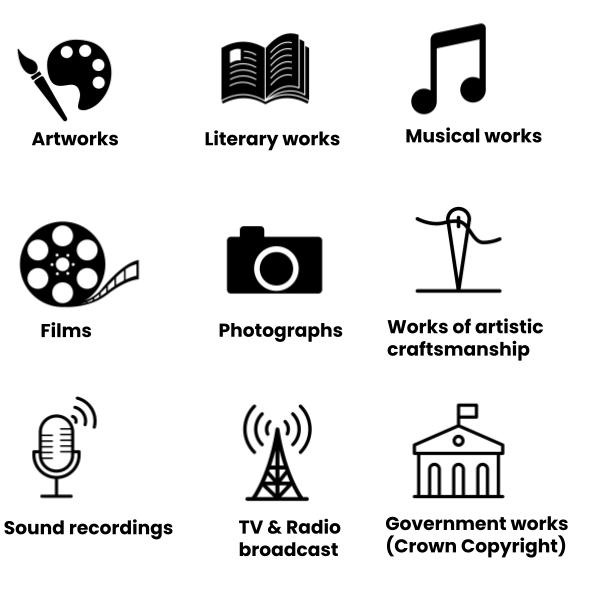
Artworks - refers to graphic works and includes drawings, paintings, sculptures, postcards, sculptures, collages. Includes artistic works that are either in a physical or digital form.
Literary works - Books, manuscripts, magazines, pamphlets, newspapers, online blogs or articles.
Musical works - musical scores and arrangements.
Photographs - includes digital files, physical photographic prints, negatives and scans.
Films - includes a recording of moving image captured in a physical or digital form (video tapes, CD, digital video file, film negative).
Works of artistic craftsmanship - includes embroidery, tapestry, needlework and other crafts, as well as handmade ceramics, handmade jewellery and crafted furniture.
Sound recordings - a recording of music in a physical or digital form (cassette tape, CD, digital file).
Dramatic works - includes works of dance or mime and film scenarios or scripts.
TV & Radio broadcasts - refers to any wireless broadcast, cable transmission, or internet streaming of sounds and visual images for reception by the public.
Government works - Includes Bills, legislation, reports, Hansard debates, inquiries.
Layers of copyright
Works can incorporate multiple layers of copyright. This underlying material creates layers of copyright protection in the same item. For example, elements of copyright protected material may have different owners, and different types of copyright-protected material have different copyright durations.
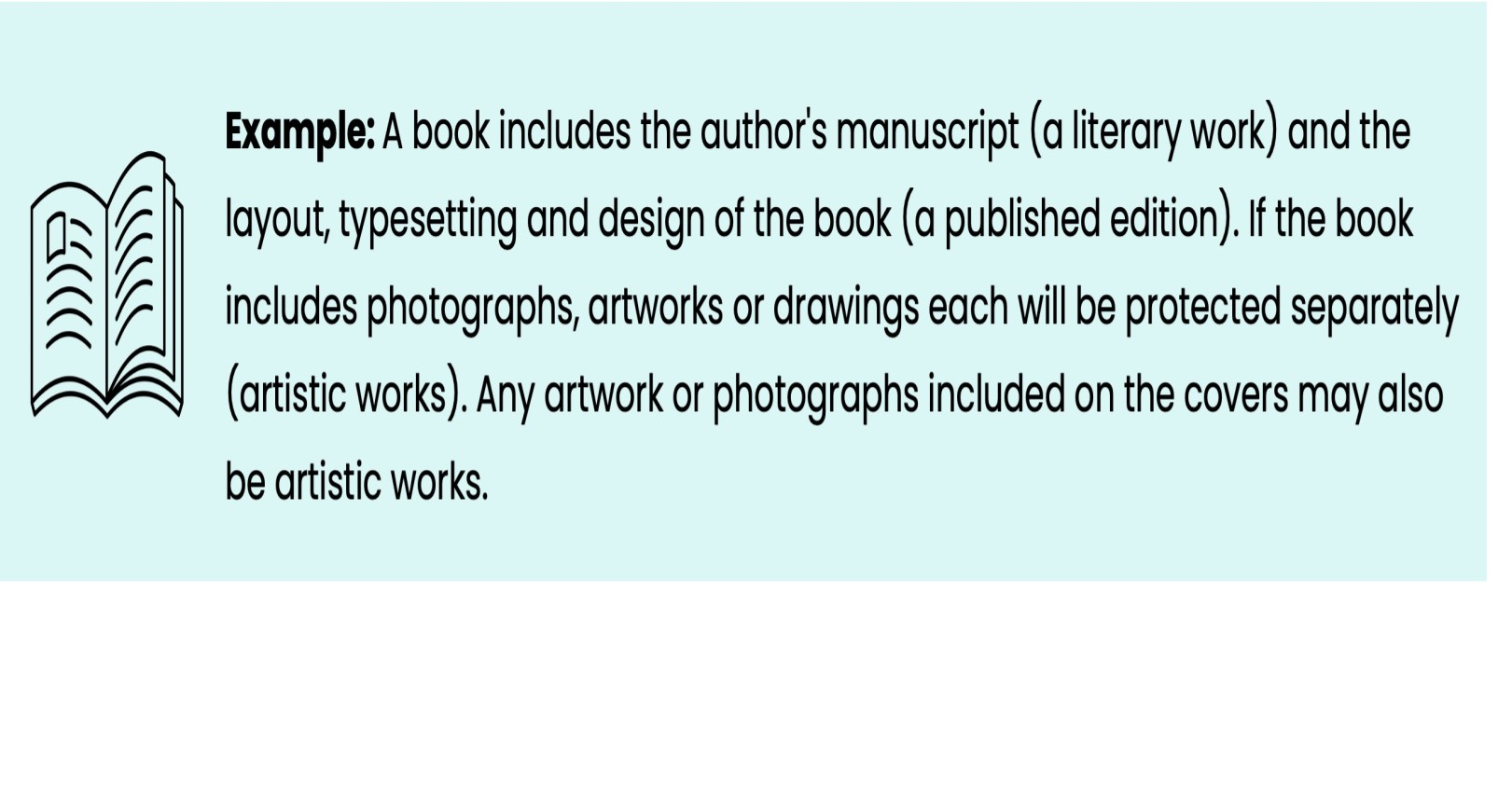
Does copyright protect ideas?
Copyright only protects tangible (physical), fixed expressions of a work. It does not cover the following items:
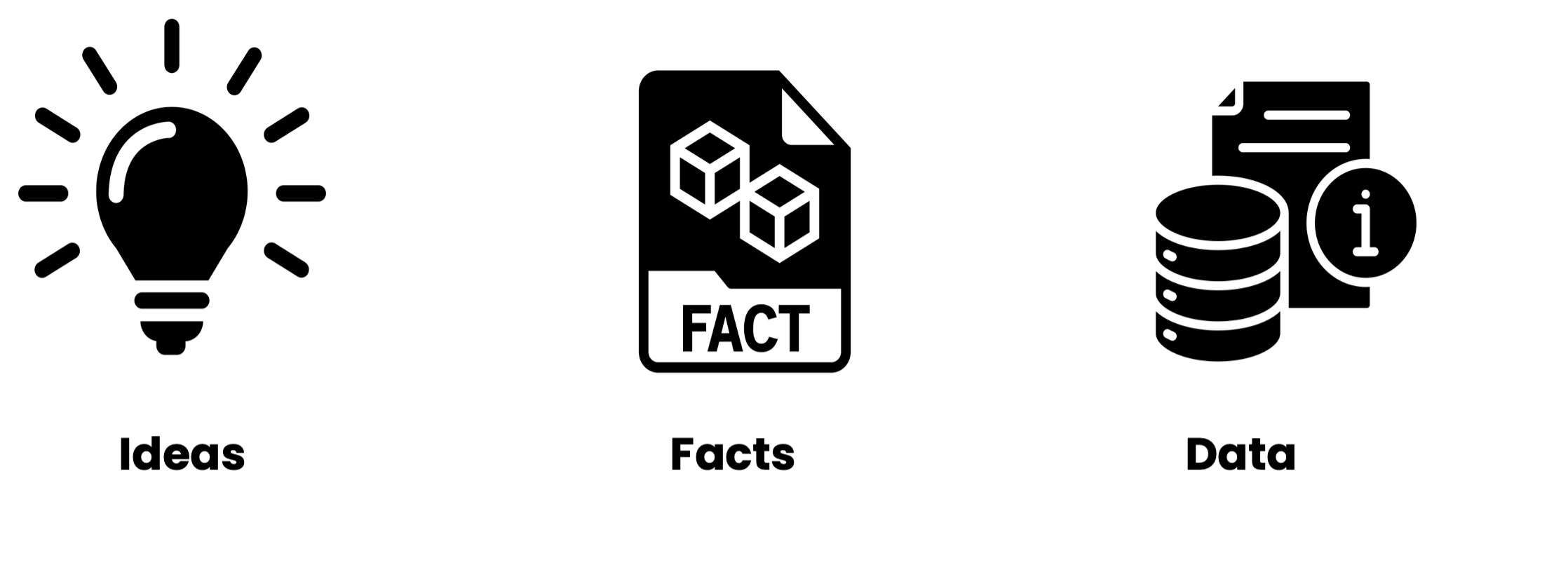
COPYRIGHT DURATION How long does copyright last?
Copyright in a work only lasts for a set amount of time and does not last forever.
Copyright exists as soon as an original work is created. The work is in copyright throughout the life of a creator. Once the creator passes away then a set amount of time must pass before copyright expires. This time is different depending on what location you are in. The table below sets out copyright duration across the Pacific region.
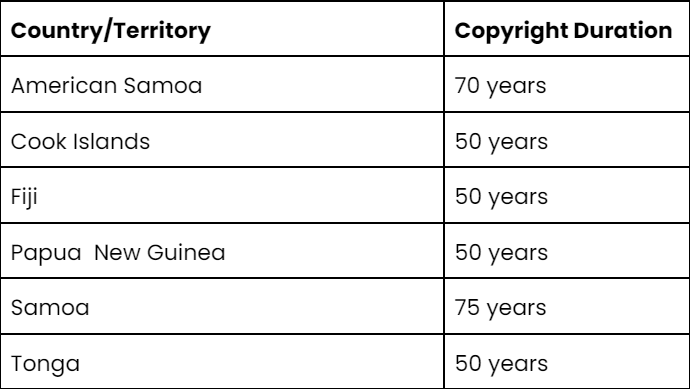
Once copyright expires, it enters the Public Domain, and it can be used for any purpose - even commercial uses.
What is the Public domain? The public domain is the name given to a set of creative works that are no longer protected by copyright law. Public domain works can be used for any purpose.
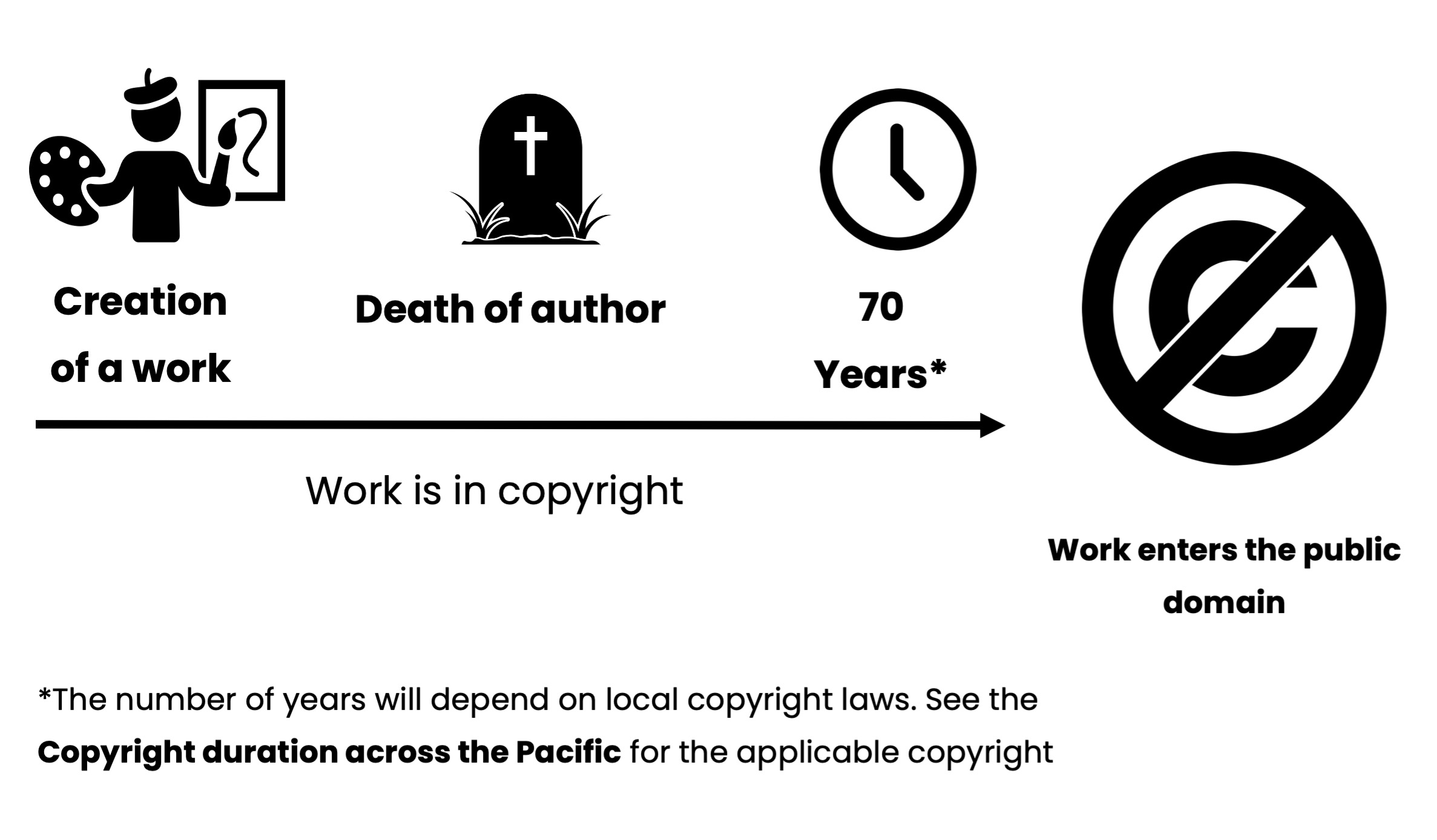
Creation of a work:
Copyright exists as soon as an original work is created. The work is in copyright throughout the life of a creator.
Death of author:
Once the creator passes away a countdown begins.
Copyright duration:
Copyright duration of a work once a creator has passed away will be determined by where the copying of the work is taking place. Please refer to the Copyright duration across the Pacific table below.
The date is taken from the end of the year in which the author has passed away.
For example if an author passes away in June of 1995, then the date is counted from 31 December 1995.
Copyright duration across the Pacific
Content made available through Digital Pasifik has been shared from a wide range of cultural institutions across the Pacific region. Most Pacific countries or territories have their own set of copyright laws with different rules. The rule of thumb is to apply the copyright law in the location of where you are copying a work.
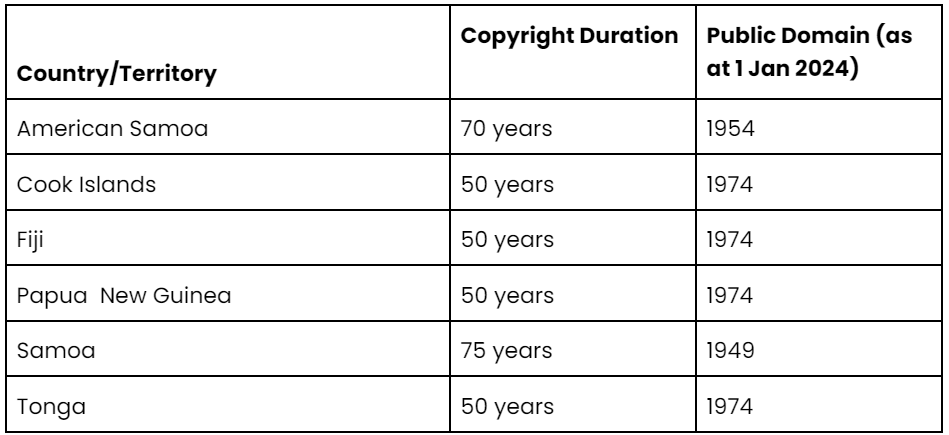
A full list of copyright laws across the Pacific is available here

Public domain:
Once the copyright duration time period (of 50, 70 or 75 years depending on location) then the work enters the public domain on the 1 January.
COPYRIGHT OWNERSHIP
Who owns copyright?
Individual owner

Copyright in a work is typically given to the first creator of the work, for example if you have painted a artwork, or written a novel then you would generally acquire the copyright in your creation and be the copyright owner.

Joint ownership
Joint creators of a work share the copyright ownership of a work equally. Copyright exists in the work until the last surviving creator has passed away, and the relevant time has elapsed.

Employer
There are some situations where this may differ, including if you have an employment agreement that states that your employer owns the copyright to work created during the term of your employment - in this case the employer would own the copyright.

Commissioned work
Another instance is when a work is commissioned. In New Zealand, if someone commissions a portrait then the copyright of that final work is owned by the person who commissioned the work, not the creator. However, if there is a contract that states the creator retains copyright then this rule won’t apply.

EXCEPTIONS TO COPYRIGHT
Are there any exceptions to copyright?
Most copyright laws have exceptions that allow copyright or use of a work for specific purposes. The most common exceptions are rules that allow the fair dealing or fair use of a work.
Fair dealing
Fair dealing is a concept in most countries and allows the following uses:
Private research or study
This means you can make a single copy of a work for your own personal use, so long as the copying is fair, and you can’t share it.
Criticism, review and news reporting
This means you are able to copy a work provided there is sufficient acknowledgement, i.e. identifying the author/source and date of the work. You can make multiple copies of a work, so long as it is fair.
Parody and satire
Some countries allow the use of a work for the purposes of parody or satire. New Zealand does not have this exception, but Australia does.
What would be considered fair depends on things like:
the reason you were copying the work;
the nature of the work itself;
whether you could have bought it;
whether the copying would affect the market for it; and
the amount copied in relation to the whole (there’s no magic 10% or allowable number of pages).
Fair use
Fair use is a defence that you may be able to rely on when using a work in limited situations. The defence of fair use is available to America and Pacific countries and territories that follow US copyright law including: American Samoa, Chuuk, Guam, Hawai’i, and Kosrae.
A detailed list of copyright laws across the Pacific is available here.
HOW CAN I LEGALLY SHARE A WORK? Can I share a work found through Digital Pasifik?
You may be able to share or reuse a collection item found on Digital Pasifik. We encourage you to check the copyright status displayed alongside the collection content and for more information please see our use and reuse
You may also consider the following:
If copyright in the work has expired. Did the creator of the work pass away more than 70 years ago?
If the intended use of the work falls under a fair dealing exception, or could be classed as fair use.
Contacting the organisation or institution where the work is held and asking for help in obtaining permission to use the work.
How do I ask permission to use a work?
If the copyright owner is easily identifiable and you have their contact details, the best way to ask permission is having a conversation with them either over the phone, via an email, or through a written letter. Get their copyright permission in writing if you can.
Example of copyright information displayed with collection items on Digital Pasifik
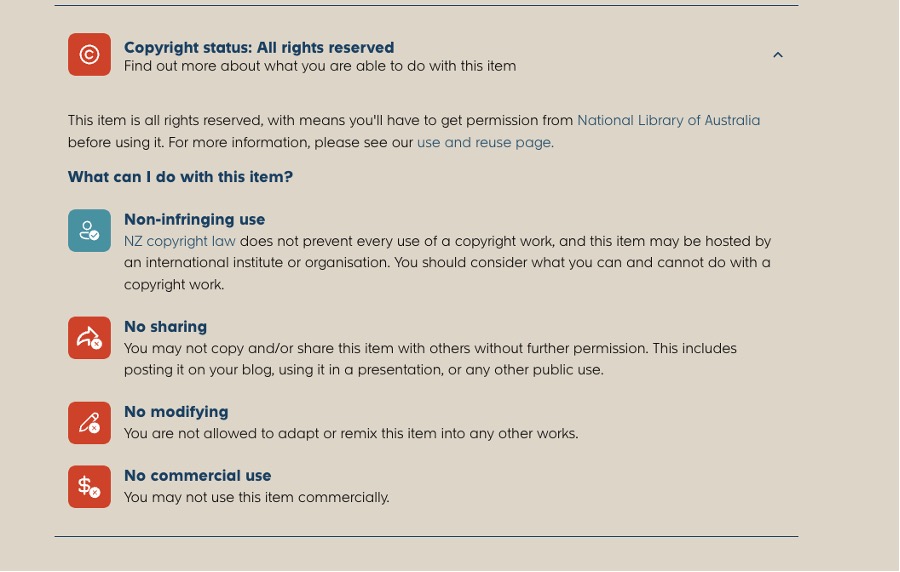
Using Public Domain works
Where a work is clearly out of copyright and in the public domain, the following principles set out good practice to follow when reusing these works.
Attribute the source. Credit both the author/creator and the providing institution (e.g., archive, museum, library) of the work.
Respect the original. Clearly indicate any modifications made to the original work when redistributing it.
Share knowledge. When utilising public domain works to create new content or if your are able to provide additional information, such as the work's origins, authorship, or related rights holders, please share your knowledge with the institution that holds the original object.
Cultural sensitivity. If the work includes culturally sensitive elements you should not change or use these in ways that might be derogatory to other cultures or communities.
Preserve public domain status. Do not remove public domain marks or notices, and ensure accuracy in conveying the work's copyright status.
These guidelines are derived from the Europeana Public Domain Usage Guidelines.
FAQ
Can I share an image I find on Digital Pasifik on Facebook or other social media platforms?
You are able to legally share a link to the work on your Facebook page or other social media without infringing copyright.
Can I use an image on a Youtube video?
You should only share works on You
tube that are out of copyright (public domain works), or where the copyright information indicates you are allowed to share. If the work is still in copyright, then you may need to seek permission from the copyright owner.
Can I copy an image to use in a community newsletter?
Sharing works that are out of copyright is the best option. Look for content where the copyright information indicates you are allowed to share. If the work is still in copyright, then you may need to seek permission from the copyright owner.
Can I copy a work to use in my own creative works? Copying the whole or substantial part of a work in your own creative works would only be possible if the work is out of copyright, or the copyright information indicates you are allowed to modify or remix the work.
Can I copy a work to use in my class presentation?
This use would typically fall under an educational use, or an examination exception.
Can I copy a work to use in a blog post?
Sharing works that are out of copyright is the best option. Look for content where the copyright information indicates you are allowed to share. If the work is still in copyright, then you may need to seek permission from the copyright owner.
Glossary of terms
Author: Typically refers to the creator of a work.
Copyright: Legal protection granted to the creators of original works, giving them exclusive rights to use and distribute their work for a limited time.
Public Domain: Works that are not protected by copyright law because their copyright has expired.
Fair Use: A legal doctrine that allows limited use of copyrighted material without permission from the copyright owner for purposes such as criticism, comment, news reporting, teaching, scholarship, or research, under certain conditions.
Fair Dealing: A legal concept similar to fair use, but specific to some jurisdictions, allowing for the limited use of copyrighted material without permission for purposes such as research, private study, criticism, review, or news reporting, subject to certain conditions and limitations.
The information on this site has been gathered from our content partners.
The names, terms, and labels that we present on the site may contain images or voices of deceased persons and may also reflect the bias, norms, and perspective of the period of time in which they were created. We accept that these may not be appropriate today.
If you have any concerns or questions about an item, please contact us.